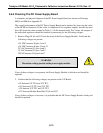
Teledyne API Model 401 O
3
Photometric Calibrator Instruction Manual, 01124, Rev. J2
Four Temperature linearization circuits are contained on the DC Power Supply board. The
outputs of these circuits can be checked by measuring the voltages at test points on the board as
follows:
TP1 Sample Temp
30
° C=2.5V, ± 0.125V/°C
TP2 Source Lamp Temp
50
° C=2.5V, ± 0.125V/°C
TP3 IZS Lamp Temp
50
° C=2.5V, ± 0.125V/°C
TP4 Chassis Temp
20
° C=2.5V, ± 0.125V/°C
If any of these voltages is incorrect, check thermistor operation as described in Section 9.6.2. If
thermistors are operating correctly, it is probable the DC Power Supply Board is defective and
should be replaced.
9.6.5 Checking The Pneumatic Sensor Board
A schematic and physical diagram of the Pneumatic Sensor Board are shown on Drawings 00402
and 00403 in Appendix D. Proper operation of the pneumatic sensor board can best be
determined by comparing the values of Flow and Pressure Test functions to measurements
obtained with independent flow and pressure meters. Flow and pressure readings can be adjusted
as described in Section 8.5.
If it is not possible to adjust the pneumatic sensor board to agree with independent flow and
pressure measurements, confirm the presence of +15 V at connector J1 pin 6. If this voltage is
not present, check the DC Power Supply Board as described in Section 9.6.4. If +15 V is present,
it is probable that the Pneumatic Sensor Board is defective and should be replaced.
9.6.6 Checking The Source Lamp And Detector
Basic operation of the source lamp and detector can be determined by observing the value of the
O3 REF test function. After the analyzer is warmed-up (15 min to 30 min after power-on), this
value will give a good indication of the state of Lamp and Detector operation as follows.
9-14


















